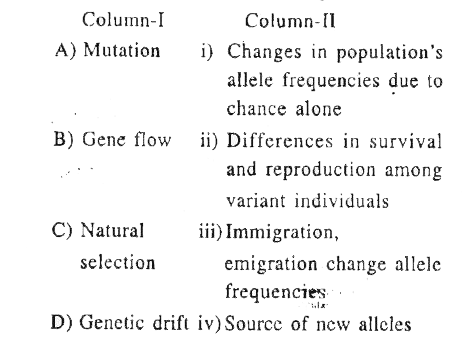Match column I with II column II and select the correct option from the given codes .
Column IColumn IIA.Griffith(i)Lac operonB.Hershey and Chase(ii)Semi-conservative DNA replicationC.Meselson(iii)TransductionD.Jacob and Monod(iv)Transformation
A-(iv),B-(iii),C-(ii),D-(i)
A-(iii),B-(iv),C-(ii),D-(i)
A-(iv),B-(ii),C-(iii),D-(i)
A-(ii),B-(i),C-(iii),D-(iv)
The correct Answer is:a
To solve the matching question, we need to connect each scientist from Column I with their corresponding discovery from Column II. Here’s the step-by-step solution:
Step 1: Identify the contributions of each scientist
1. Griffith: Known for his transformation experiment with mice, which demonstrated that a non-virulent strain of bacteria could be transformed into a virulent strain.
2. Hershey and Chase: Conducted experiments that provided evidence that DNA is the genetic material, using bacteriophages in their studies. Their work is associated with the concept of transduction.
3. Meselson and Stahl: Conducted the famous experiment that demonstrated the semi-conservative nature of DNA replication using heavy isotopes of nitrogen.
4. Jacob and Monod: Known for their work on the lac operon, which is a model for understanding gene regulation in prokaryotes.
Step 2: Match each scientist with the correct discovery
- A. Griffith matches with (iv) Transformation.
- B. Hershey and Chase matches with (iii) Transduction.
- C. Meselson matches with (ii) Semi-conservative DNA replication.
- D. Jacob and Monod matches with (i) Lac operon.
Step 3: Write the final matches
- A → (iv) Transformation
- B → (iii) Transduction
- C → (ii) Semi-conservative DNA replication
- D → (i) Lac operon
Final Answer
The correct matches are:
- A → (iv)
- B → (iii)
- C → (ii)
- D → (i)
1. Griffith: Known for his transformation experiment with mice, which demonstrated that a non-virulent strain of bacteria could be transformed into a virulent strain.
2. Hershey and Chase: Conducted experiments that provided evidence that DNA is the genetic material, using bacteriophages in their studies. Their work is associated with the concept of transduction.
3. Meselson and Stahl: Conducted the famous experiment that demonstrated the semi-conservative nature of DNA replication using heavy isotopes of nitrogen.
4. Jacob and Monod: Known for their work on the lac operon, which is a model for understanding gene regulation in prokaryotes.
- A. Griffith matches with (iv) Transformation.
- B. Hershey and Chase matches with (iii) Transduction.
- C. Meselson matches with (ii) Semi-conservative DNA replication.
- D. Jacob and Monod matches with (i) Lac operon.
- A → (iv) Transformation
- B → (iii) Transduction
- C → (ii) Semi-conservative DNA replication
- D → (i) Lac operon
The correct matches are:
- A → (iv)
- B → (iii)
- C → (ii)
- D → (i)
Topper's Solved these Questions
- MOLECULAR BASIS OF INHERITANCEBOOK - NCERT FINGERTPS ENGLISHCHAPTER - MOLECULAR BASIS OF INHERITANCEEXERCISE - HOTS
8 Videos
- MOLECULAR BASIS OF INHERITANCEBOOK - NCERT FINGERTPS ENGLISHCHAPTER - MOLECULAR BASIS OF INHERITANCEEXERCISE - NCERT
28 Videos
- MICROBES IN HUMAN WELFAREBOOK - NCERT FINGERTPS ENGLISHCHAPTER - MICROBES IN HUMAN WELFAREEXERCISE - Microbes In Human Welfare
138 Videos
- ORGANISMS AND POPULATIONBOOK - NCERT FINGERTPS ENGLISHCHAPTER - ORGANISMS AND POPULATIONEXERCISE - Organisms And Population
175 Videos
Similar Questions
Match Column-I with Column-II and select the correct option from the codes given below.

View SolutionMatch column I with column II and select the correct option from the given codes.
Column IColumn IIA.Rhinoceros(i)High endemismB.In situ conservation(ii)Off site conservationC.Ex situ conservation(iii)On site conservationD.Hotspots(iv)Kaziranga
(a) A-(iv), B-(iii), C-(ii), D-(i)
(b) A-(iv), B-(i), C-(ii), D-(iii)
(c) A-(iv), B-(ii), C-(iii), D-(i)
(d) A-(iv), B-(i), C-(iii), D-(ii)
View Solution
Knowledge Check
Mathc column I with column II and select the correct option from the given codes.
 AA-(ii), B-(iii), C-(iv), D-(i), E-(v)BA-(v), B-(iv), C-(iii), D-(i), E-(ii)CA-(i), B-(iii), C-(iv), D-(ii), E-(v)DA-(i), B-(iv), C-(iii), D-(ii), E-(v)
AA-(ii), B-(iii), C-(iv), D-(i), E-(v)BA-(v), B-(iv), C-(iii), D-(i), E-(ii)CA-(i), B-(iii), C-(iv), D-(ii), E-(v)DA-(i), B-(iv), C-(iii), D-(ii), E-(v)Mathc column I with column II and select the correct option from the given codes.
 AA-(iii),B-(v), C-(iv),D-(ii)BA-(ii),B-(iv),C-(v),D-(i)CA-(ii),B-(iv),C-(v),D-(iii)DA-(iii), B-(v), C-(iv), D-(i)
AA-(iii),B-(v), C-(iv),D-(ii)BA-(ii),B-(iv),C-(v),D-(i)CA-(ii),B-(iv),C-(v),D-(iii)DA-(iii), B-(v), C-(iv), D-(i)Match column I and II and select the correct option from the given codes.
 AA-(iii),B-(iv),C-(i), D-(v), E-(ii)BA-(iii),B-(i),C-(iv), D-(v), E-(ii)CA-(iii),B-(iv),C-(v), D-(i), E-(ii)DA-(ii),B-(iv),C-(i), D-(v), E-(iii)
AA-(iii),B-(iv),C-(i), D-(v), E-(ii)BA-(iii),B-(i),C-(iv), D-(v), E-(ii)CA-(iii),B-(iv),C-(v), D-(i), E-(ii)DA-(ii),B-(iv),C-(i), D-(v), E-(iii)
Match column I with column II and select the correct option from the given codes
Column IColumn IIA. Hardwood(i). DuramenB. Soft wood(ii). AlburnumC. Heartwood(iii). Non-porous woodD. sapwood(iv). Porous wood
View SolutionMatch column I with column II and select the correct option from the given codes.
Column IColumn IIA. Salivary amylase(i)ProteinsB. Bile salts(ii)Milk proteinsC. Rennin(iii)StarchD. Pepsin(iv)Lipids
View SolutionMatch column I with column II and select the correct option from the gives codes.
ColumnIColumnIIA.Wings(i)ReptilesB.Operculum(ii)ChondrichthyesC.Scutes(iii)BirdsD.Cartilaginous endoskeletion(iv)Osteichthyes
View SolutionMatch column I with column II and select the correct option from the codes given below.
Column IColumn IIA.Mitochondria(i)Without membraneB.Lysosomes(ii)Single membraneC.Ribosomes(iii)Double membraneD.Nucleus
View SolutionMatch column I with column II and select the correct option from the given codes.
Column IColumn IIA.Translation(i)Aminoacyl tRNA synthetaseB.Transcription(ii)Okazaki fragmentsC.DNA replication(iii)RNA polymerase
View Solution
